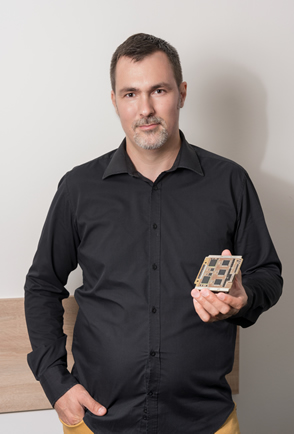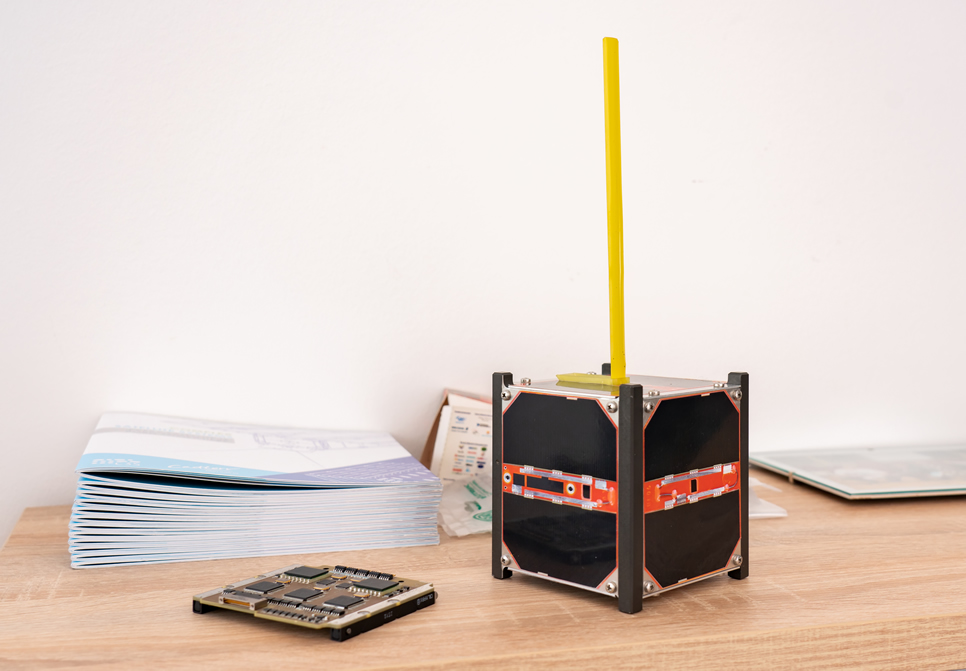
Gyula Horváth, founder of C3S Ltd.
The objective of the Support of business RDI activities (VÁLLALATI KFI_16) is to promote the research-development and innovation activities of domestic businesses. The objective of the call is best achieved by supporting domestic research, development and innovation activities which result in new marketable products, technologies with a high intellectual added value, furthermore the development of their prototypes. The source of funding is the National Research, Development and Innovation Fund.
Maybe, there is no other industry which would meet the criteria of “high intellectual added value” better than space industry. The engineers of C3S LLC. implementing the satellite technology developments joined the developments related to space activities with their ideas, expertise and experimental experience as a business employing a few dozens of people.
- In 2007 Gábor Marosy, technical director of C3S at present, visited me in my office at the Budapest University of Technology. He just arrived from a Polish-Hungarian conference where he had heard that the Poles had been developing a small CubeSat with a volume of one litre. The idea of us doing the same was born immediately - recalls Gyula Horváth, founder and managing director telling the story of C3S LLC. - This was based on the fact that by then space activity (including space research and space industry) had already had a history of more than forty years. It was after this that we started to develop the Masat-1 satellite in cooperation with the researchers and students of the Budapest University of Technology. The highlight of the story was the launching of the Vega carrier rocket on 13 February 2012, it put Masat-1 in orbit and the satellite started its successful operation of 1,061 days.
Two months later, some researchers who had participated in building Masat-1 established the C3S LLC., the name of which is the abbreviation of Complex Systems and Small Satellites. The objective was to develop satellite platforms which expressly blend research and industry. Here the notion of platform includes all the sub-systems required to operate a satellite, i.e. everything except for payload. This ensures that the satellite works under the adverse circumstances in space, the payload is supplied with energy and the data collected are transmitted to the Earth. According to the arguments put forward by Gyula Horváth, the platform “can be merchandised”, i.e. similar (though not exactly the same) platforms may sell well on the market of space industry.
- Small-sized satellites are not only cheaper, but the satellite carrier, i.e. the platform is suitable for several different purposes. Even fleet may be constructed from such small satellites. So, we have set the aim of developing such small satellite platforms - said Gyula Horváth. - First, we developed platform technologies in cooperation with the European Space Agency (ESA). Now we develop an entire satellite platform as a participant of the RADCUBE cooperation.
In the framework of the RADCUBE cooperation, C3S LLC. develops the second Hungarian satellite jointly with the space dosimetry research group of the Centre for Energy Research of the Hungarian Academy of Sciences. Researchers from several countries participate in the consortium, but the project is led by the Hungarians. On the CubeSat three times the size of Masat-1, the instrument for radiation measurement developed by the space dosimetry research group will operate (the research group has been developing similar devices for several space missions for decades). In addition, other staff of C3S are specialised in the power distribution of satellites, which is in demand due to the shortage of these skills in European space industry. They will use the funding awarded to them by the NRDI Office in the framework of the “Support of business RDI activities” to implement power distribution-related developments.
- Though our company does have a “terrestrial” industrial branch, yet our main line of activities is the development of satellite technologies. This is important for several reasons. It provides an opportunity for students of engineering to gain experience in space industry, it helps our company have references, which is a precondition for receiving further orders - continues Gyula Horváth. - So far, the ESA has ordered such small-sized satellite platforms from as few as two companies and one of those two companies is ours. Hungary with Masat-1 became one of the 50 nations who sent their own satellite to space; what is more, we are one of those eight countries which were able to build the satellite completely by themselves.
In spite of their small size the satellite platforms developed by C3S have several components. They take care of energy supply based on solar cells, on-board data gathering, communication with the Earth, the functioning of the on-board computer, the stabilisation of the trajectory and the integration of the payload. But do we have a chance of achieving something in space in addition to the traditionally predominant Americans, Russians or the French and Chinese?
- Skills that are necessary for success in space industry are difficult to acquire in school, this requires participation in real space industry development projects - says one of the founders of C3S. - Whereas in traditional industries, such as the automotive industry, engineers represent only a small part of workforce. As opposed to this, in space industry, this is the most populous group of employees. Here products are small in number, but the intellectual added value is nearly inestimable. Planning, testing and production technology need to be flawless because it is not possible to repair anything afterwards. We already employ 30-35 people, which means that we are not a small company even by European standards, as not even the research-development divisions of large companies employ a higher number of staff in one special area. Engineering capacity of this size is feasible also in Hungary and can function at a rate of efficiency which is far beyond that in other industrial sectors.







